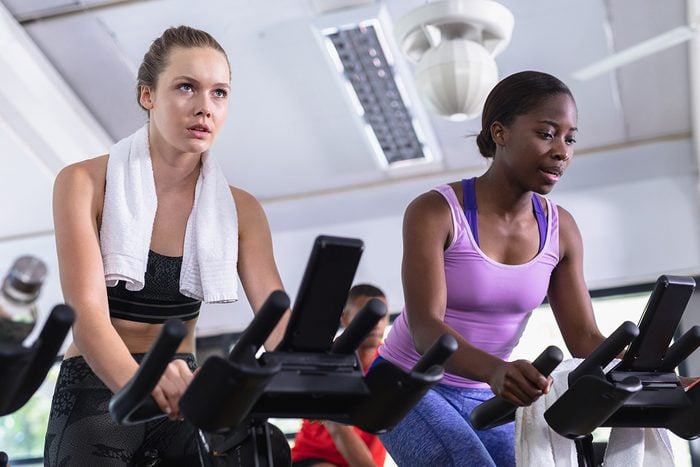
Stop spinning your wheels
It turns out making mistakes in spin class can be pretty common. So we talked to Cydney Lebovitz, the co-lead instructor and performance coach at Cyclebar Leaside in Toronto, about how to optimize each class. Read on to learn about the five most common spinning mistakes.
(Related: 5 Common Exercise Mistakes Everyone Makes—And How To Fix Them)
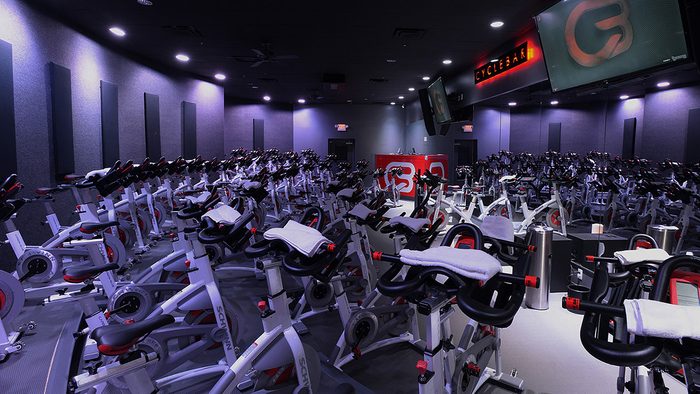
Spinning Mistake #1: Your bike isn’t set up properly
If your bike isn’t adjusted for you, you won’t be able to get the most out of your cycling class: you won’t be able to keep up with the class, you won’t be able to challenge yourself enough and, worse, you stand a chance of injury. Here’s how Lebovitz says to adjust your bike.
- The seat should be at the same height as the hipbone. That creates a slight bend in the knee when the bum is on the seat and the leg is fully extended. Check both legs. “If a bike seat is too high, you will not be able to use your leg muscles correctly to push out of the saddle, and can possibly cause a knee injury,” says Lebovitz. And if the seat is too low, your knees may become strained in the seated position, particularly during a heavy climb, she adds.
- The distance between the handlebars and the seat should be about the length of your forearm. Another good way to check this is to sit on the bike and make sure that your knee does not go ahead of your foot when you pedal. You can adjust this by moving either the handlebars, the seat or both. “The knee should not be bent more than 90 degrees during rotation,” says Lebovitz. And, “handlebars should be approximately one to two inches higher than the seat.” The higher handlebars, the easier the ride will be on your core and back.
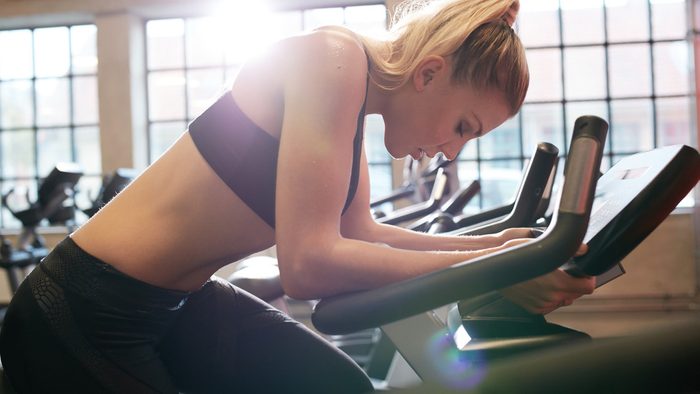
Spinning Mistake #2: Your posture is wrong
Now that your bike is adjusted, ask yourself how you feel on the bike. Are you comfortable? Is the movement smooth as you push the pedals? If you said no to any of those questions, check out this riding posture checklist and adjust your form.
- Are your sit bones (the ischial tuberosity, which you feel in your bum when you sit down) planted evenly and balanced on the saddle (spin talk for bike seat)? When you’re standing on the pedals, is your body hovering over the middle of the bike?
- Are your flat feet on the pedals?
- Do you have a slight bend in your elbows and a light grip on the handlebars?
- Is your core engaged? If someone were to come and poke you in the side, would you keep your balance on the bike?
Balance is key, says Lebovitz. It helps you engage the glutes and quads properly (and get a better workout). “You will be able to focus more on specific muscle groups and increase their power output or watts.”
(Related: Why Exercise Can Be the Most Effective Way to Relieve Stress)
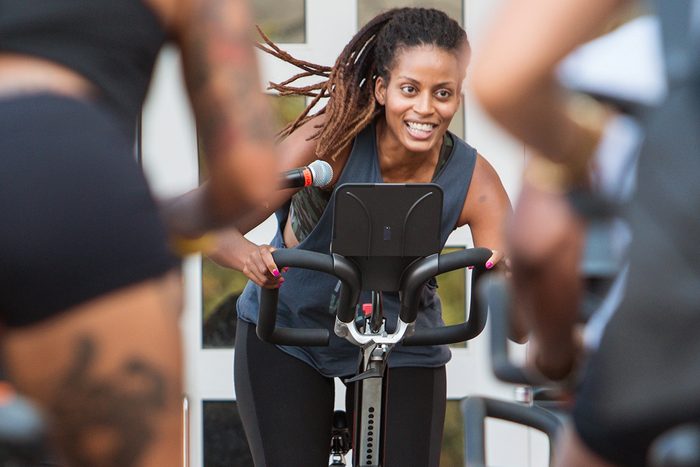
Spinning Mistake #3: Taking it easy
With spin, you have full control over how intense a class will be. “From person to person, gear 10, at a given cadence, can feel very different,” says Lebovitz. “Even day-to-day, a person’s energy and ability may fluctuate.” So how heavy the tension you put on your bike (by turning that knob which is typically below the handlebars) is personal, says Lebovitz.
“A good sweat, raised heart rate and breathlessness are generally pretty good indications of hard work in a given ride,” says Lebovitz. If it’s feeling easy, turn the knob until you’re feeling it in your legs.
Lebovitz says to compare your workouts too—remember where on the dial you worked. “As a general rule, if the power average does not seem to be improving over say 10 or more rides, the rider is probably not using enough power.”
(Related: Why You Should Buy Cycling Shoes if You Use an Exercise Bike at Home)
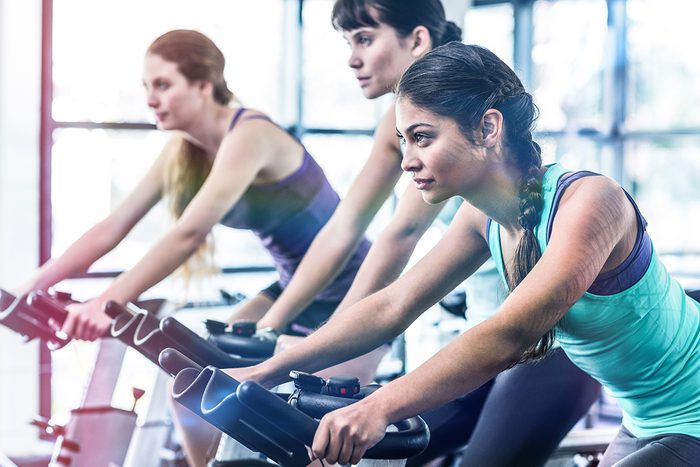
Spinning Mistake #4: You’re spending too much energy too early
Good spin instructors make sure that the class is paced effectively. This includes a good warm-up, intense cardio, sufficient strength conditioning and a much-deserved cool-down and stretch. Lebovitz says: “We tell new riders to keep it very easy for the first half of a class in order to ensure they have enough ‘left in the tank’ for the whole ride. With experience, riders get a feel for how hard they should start off in order to finish the class.” Use the structure of the class to get the most out of it, and use your warm-ups as that, not a gunfire sign to take off.
(Related: 5 Ways to Stretch Your Ankles so You Can Move Easier)
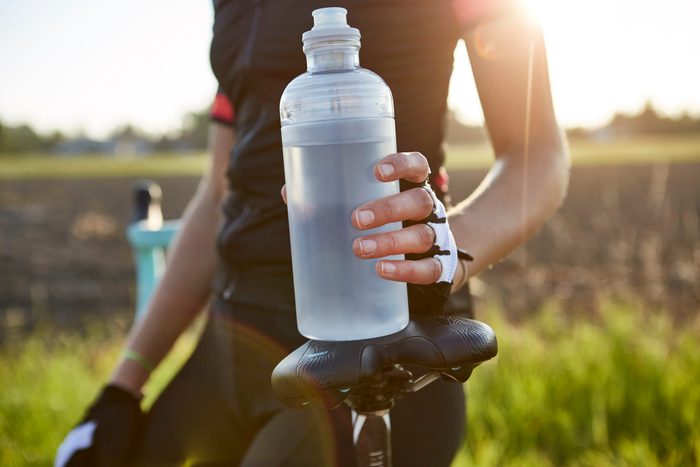
Spinning Mistake #5: You’re not drinking enough water
When it comes to spin class, taking small water breaks are always worth it. “If you’re not hydrated enough, the body can’t properly do its job to cool itself down. In extreme cases, lightheadedness can occur if a rider is dehydrated,” says Lebovitz. First, make sure you’re hydrated before class by going to the bathroom. Lebovitz says to look at the colour of your urine: Too yellow, under hydrated; too clear, over how hydrated; and somewhere in the middle is just right.
You’re going to feel thirsty during class, so drink when you do feel parched. You should be drinking somewhere between a half to a full litre of water. “Take more frequent, smaller sips of water to avoid stomach discomfort.”
(Related: Should You be Drinking Chlorophyll Water?)

Spinning Mistake #6: You’re counting on spinning for everything
Exercise doesn’t go as far if you have unhealthy habits in other areas of your life. “Like any high-intensity workout, performance is enhanced by a healthy diet, enough sleep, a positive attitude and lots of practice. There is a very high learning curve for the new rider and it can be exciting to see [progress] after just a few weeks of sweating it out on the bike.”
